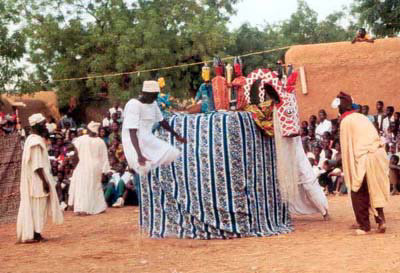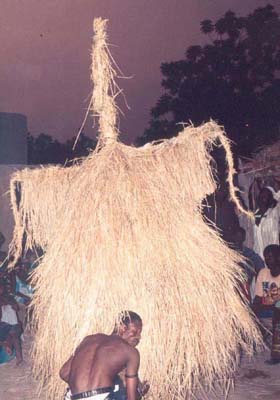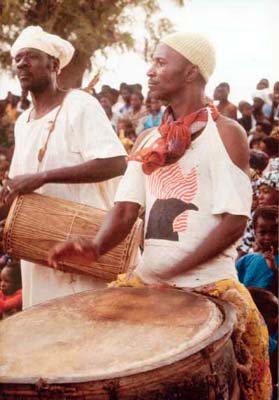Puppets and masks of the Bamanan and the Bozo (Mali)
by Elisabeth den Otter
During the masquerades of the Bamanan and Bozo of Markala, a village along the Niger river, large puppets in the shape of mythical animals (sogow) are made to dance by puppeteers that are hidden inside. Some of the animals carry small rod-puppets on their back, which 'dance' as well. They alternate with masked dancers, equally representing mythical animals and symbolic persons. These hidden dancers express the character represented by the puppet or mask, through their movements. There are visible dancers as well: the guide who accompanies a sogo or a mask, and dancing with it, often in unison, and the members of the youth association (ton), who perform circle dances and have jumping contests. Moreover, individuals from the public may dance with a puppet or mask to show his or her respect or admiration.
Music, song and dance play an important role during the masquerade. Much better than the spoken word, they convey and reinforce emotions and create a special atmosphere. With the participation of the bystanders, this truly can be called 'total theatre'.
The Bamanan
Just before the arrival of the rains, in the beginning of June, many villages in the area of Markala (near Ségou) hold their annual masquerade, a public event performed on the village plaza. The one celebrated by the Bamanan and Bozo of the Kirango-quarter is described in more detail below. The Bamanan are one of the largest ethnic groups of Mali and live in the centre of the country. They are agriculturalists, but since they live near the Niger river they share their existence and space with the Bozo fishermen. Both groups have their own form of masquerade.
The masquerade generally takes place on three consecutive afternoons and two nights. The organisation is in the hands of the ton. Membership is mandatory for men from 14-40 years old, and women from 14 until marriage at about 20. They are divided into four age groups, which can be recognised by the colours of their clothing.
Dance plays an important role during the masquerade. Puppets, masks and people dance, each in their own way and for their own purpose. The dances of the puppets and masks (by hidden dancers) serve to express their characters, whereas the (visible) people-dances are a means of expressing feelings of togetherness and joy.
The masquerade
No difference is made by the Bamanan between puppets and masks; both are called 'mask', and serve the same purpose: to represent mythical and symbolic beings through concealed human beings.
The sogow represent mythical animals and human beings. The body of the animal is quite large: a frame measuring around 2 metres long and 1,5 metres high. It is covered with cloth, in order to conceal the 2-3 puppeteers inside who manipulate the rod puppets. The head of the animal is a large rod puppet. Smaller rod puppets are sometimes carried on the back of the animal or attached to its horns. The dramatis personae are humans, spirits and mythical animals, metaphors for the full range of human virtues and vices. Animals of the savannah are represented in the form of antelopes, buffaloes, birds and domesticated animals. The bush buffalo, Sigi, symbolises strength and the power of tradition. On his back, he may carry women pounding millet, a crocodile, a mother-with-child, musicians, and a female dancer. Each animal dances according to his character, and so Sigi's dance is slow and stately. At times, the animal stops, to give the smaller rod puppets on its back a chance to go through their motions: the women pound, the farmer hoes, the musicians play and the dancer twirls around.
Drawing: Hetty Paerl
The well-liked Kono, the holy bird that announces the rains, prances around the plaza in a very elegant way, flapping his wings.
The masked dancers also represent mythical animals, like Ngofariman, the Mean Chimpanzee. He is a very provocative character and dances around kicking up a (sand-)storm and approaching women in a lewd way. Taasidoonin (Think a Little), a sexy woman, dances in a rather teasing and voluptuous manner. Bilanjan, a sogo entirely made of straw, and who only may be seen at night, is a bush-spirit.
Since the puppeteers and the masked dancers cannot see their way, they need someone to guide them. This is done by a man shaking a hand-bell and giving them verbal instructions as well. When the performance reaches a high point and the puppet dances the best he can, the musicians come closer, play more intensely, and the guide dances around it, leaping high into the air. The puppet, its guide, and the musicians become one single sound and movement, reason for the public to approach and raise one of their arms as a sign of praise. Sometimes people will dance behind a puppet or a mask, to 'accompany' it, as a sign of admiration.
During the Bamanan masquerade, the Bozo fishermen do guest-appearances with their sogow in the shape of various types of fish, a hippopotamus, etc.
These puppets, aquatic animals that have no legs -except for the hippo- are manipulated at night only by a puppeteer who crawls around on his belly to move them. Therefore, they are not rod puppets, but 'body puppets' as it were. They are also accompanied by a guide with a hand-bell and musicians playing drums, although the dance style of the Bozo is slightly different from that of the Bamanan. Their day puppets are much like those of the Bamanan, such as a bird or an antelope. The puppets and masks are paraded on boats that drift by on the Niger river, close to the beach. The musicians, singers and an occasional dancer are seated in boats as well. An amazing sight!
Dancing people
Apart from dance forms directly related to the performances of the puppets and the masks, members of the youth association perform circle dances in which both men and women participate, the women forming an inner circle and the men an outer circle.
The oldest age set is at the beginning of the row, the youngest at the end. The oldest group of men wears white robes, the second group reddish-brown robes, the third group blue tops and white pants, and the youngest group white tops and blue pants. The oldest women wear white tops on black skirts, the medium age-groups yellow or bogolan (mud-cloth) outfits, and the youngest blue tops on white skirts. The first dance they perform is called komofoli, which is originally an initiation dance. (Komo is one of the initiation societies of the Bamana, foli means 'music' or 'to play the drum'.) The men and women dance in line in what looks like a rather simple way: a few steps, followed by a small jump and a half-turn, and so on. The arms sway loosely, following the movements of the body. Each dancer gives his or her own personal touch to this elegant dance which looks deceptively easy. At times, onlookers will raise a dancer's arm or tie a scarf around his or her waist as a sign of appreciation. During the bonjalan, pairs of young men make high jumps in the air and summersaults, showing off their agility and strength.
All these different ways of dancing by puppets, masks and humans is accompanied by drumming and singing. The lead singers and women's chorus accompany them throughout their performances. The songs refer either to particular qualities of the characters, make a reference to a particular narrative legend, or serve as metaphors for a variety of human behaviours. The songs are intended to flatter the character, to heighten its prestige, and to move the dancer to action. The music is performed mainly on drums: a large wooden kettledrum and various cylindrical drums. The female chorus keeps time with wooden clappers and calabash rattles.
For the people of Markala, the masquerade offers an opportunity to be together with relatives and friends, to show off their finest clothes, and to express their joy through dancing elegantly.
Cultural identity
Through this type of total theatre the cultural identity of the Bamana and the Bozo, as members of age groups and of a village, is reflected in the performing arts. The dances, songs, and drum rhythms are valued parts of their cultural heritage which is relived each year and adapted whenever the need arises. Puppets and masks may be seen as two sides of one coin: manipulated by man, they are located in the magic field between illusion and reality, connecting the invisible world of the supernatural and the visible world of the human. Within the framework of the masquerade the people of Markala celebrate their origins and their relation to the animals of the land and the water.
Literature: Arnoldi, M.J.
1995Playing with time. Art and Performance in Central Mali.
Bloomington and Indianapolis: Indiana University Press.Darkowska,O.
1980Théatre populaire de marionnettes en Afrique Sud-Saharienne.
Bandundu: CEEBA Publications, vol. 60.1988 L'Afrique Noire en Marionnettes.
Charlesville-Mézières: UNIMA Informations.1991 Marionnettes en Territoire Africain. Catalogue.
Charlesville-Mézières: Institut International de la Marionnette.Imperato,P.J.
1980Bambara and Malinke Ton Masquerades.
In: African Arts, vol.XIII, no.4, p. 47-85.1994 The depiction of beautiful women in Malian youth association masquerades.
In: African Arts, vol.XXVII, no.1, p. 58-65.Liking,W.
1987Marionnettes du Mali.
Paris: NEA-ARHIS.More about puppetry














